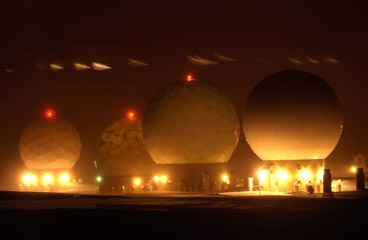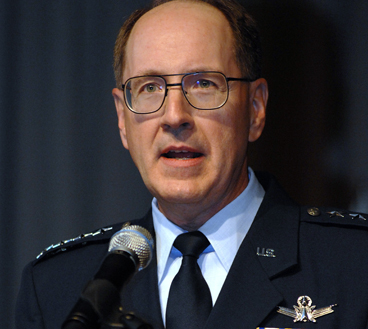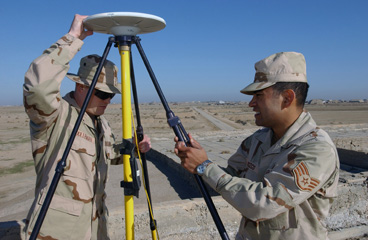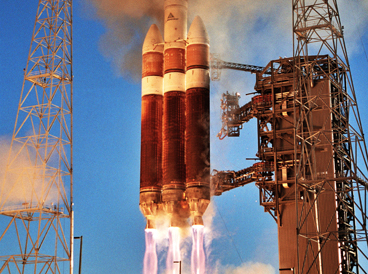Not long ago, the US military space program was sorely afflicted with multiple and severe problems—including, but not limited to, high costs, poor performance, and late delivery. The Air Force responded with a “back to basics” push that aimed to re-establish basic quality and reliability.
Today, all signs point to success. The space effort more and more seems to be strong and squarely on track.
The Air Force has put together a long string of undeniable technical and operational successes. These and other factors have convinced senior space leaders that USAF finally has a grip on its projects and can now think more broadly about the role military space will play in the future.
Such were the conclusions of US space leaders who spoke at the Air Force Association’s National Symposium on Space, in Los Angeles last November. These included USAF Gen. Kevin P. Chilton, commander of United States Strategic Command; Gen. C. Robert Kehler, head of Air Force Space Command; and Lt. Gen. Michael A. Hamel, commander of Space and Missile Systems Center.
The leaders told attendees that, in the future, the US likely will grow ever more dependent on military and commercial space activities, even as space capabilities face threats more dangerous than ever before.
 |
The last satellite of the Defense Support Program, shown in this artist’s rendering, was launched into orbit in November. (Illustration by Erik Simonsen) |
The key to the enterprise will be a dramatically enhanced ability to know what’s happening in space so as to better detect, recognize, and respond to attacks when they happen—that is, what’s known as space situational awareness.
Moreover, they noted, the nation must more thoroughly integrate military space activities with all other components of defense. In this way, space will cease to be merely an enabler of other military endeavors. The space force sometimes has to be a supported, rather than supporting, entity.
Sega’s Guidance
Kehler, USAF’s top space officer, noted that the Air Force had just successfully launched yet another Defense Support Program satellite. The launch was significant, he said, because it constituted the service’s 54th consecutive successful launch. The satellite was thought to be checking out well in space.
He praised a team of Air Force personnel and space industry firms that has compiled the impressive launch record, though he warned that the team still “needs to get stronger” because of the lingering shadow of “a time period in our not too distant past where maybe the team didn’t operate as strongly together as it needs to.”
The architect of the back-to-basics approach was former Undersecretary of the Air Force Ronald M. Sega. Under his guidance, service managers streamlined programs, stripped away extraneous requirements, focused on discharging key missions, and worked to rebuild Air Force systems engineering expertise that had been allowed to atrophy.
The Delta launch was significant, too, because it straddled two eras. It was the first operational use of the Delta IV heavy launcher, which will be a workhorse in the future. It also marked the last launch to orbit of a DSP satellite, which has been a staple of the US space constellation for nearly four decades. The DSP will be supplanted in coming years by the Space Based Infrared System satellite type, which is not yet ready for service. Both infrared systems provide early warning of missile launches.
Kehler told reporters afterward that the SBIRS sensor has been tested in orbit on another satellite for more than a year, and its results have been “spectacular.” He called the program an “absolutely critical” requirement and said it will prove to have been worth the wait once operational.
Although great progress has been made in “synchronizing” space with nearly all aspects of USAF and defensewide operations, the push is on to thoroughly integrate it into those functions, Kehler said. He expects that USAF space systems will become ever more technically capable, but without being truly integrated into all other military endeavors, it will never reach its full potential.
 |
Four satellite communication dishes, protected from the elements by “golf ball” coverings, glow in the darkness at Thule AB, Greenland. (USAF photo by Michael Tolzmann) |
“If we continue on the path we are on, we will get improved capabilities,” Kehler said, but space will continue to be “stovepiped” into other functions. By truly integrating space with air, their sum will not “equal two. … Air plus space equals 20, or … 100, or … 10,000.” Adding cyber operations “does not equal three. It’s more like 100,000. … This is called ‘compounding.’?”
The integration will come not by simply putting a space pipe into every aspect of operations, but by building network architectures where everything can talk to everything else.
“You’ve got to have data standards,” Kehler said. “Everybody has to be operating on the same sheet of music.” Data will have to be shared not just by people, but by platforms that can synthesize the data and produce a value-added product.
Moreover, integration must come through unified doctrine “and shared tactics, techniques, and procedures,” Kehler observed. “I think we need to get at this with more intensity,” especially in the area of intelligence-surveillance-reconnaissance, he said.
The first steps in integration are well under way. Kehler noted that an “air operations center”-like facility at Vandenberg AFB, Calif.—the Joint Space Operations Center—has been stood up and serves as the global clearinghouse for “space effects.” There are also space experts embedded with the senior staff at all the other AOCs around the world. These directors of space forces will be charged with making regional commanders “aware of what space can do for [them],” especially when combined with cyber operations.
What it can do is increase the velocity of achieving effects. Aircraft, Kehler said, can achieve effects in “minutes to days. Space can deliver effects in seconds to minutes. Cyber can deliver effects in milliseconds.”
Needed: A Doctrine
He also noted that space is now a substantial part of the curriculum at the US Air Force Warfare Center at Nellis AFB, Nev., which until very recently was air-centric.
Kehler said there is a model for what must happen in the Air Force-Army effort to develop the AirLand doctrine of the 1970s. What is needed now is an “air, space, and cyber doctrine” that will seamlessly blend operations in all three domains.
In the immediate future, Kehler said it will be his command’s job to fine-tune the capabilities they provide, and speed up the process at which it can take an idea from the drawing board to launch.
“We deliver great space capabilities, but in my humble opinion, it’s taking us too long,” he said. “We need to address that.”
 |
Gen. C. Robert Kehler, head of Air Force Space Command, is pushing for further integration of space into all aspects of warfare. His No. 1 priority is space situational awareness.. (USAF photo) |
For the future, Kehler pointed to operationally responsive space efforts—the ability to launch payloads on short notice—as a major “benchmark capability.” The concept of a no-notice launch system will go hand in hand with small satellites, he said.
“We launched TacSat [in 2006]. … We’ve learned a lot” from the program, he said, that will enable “plug and play” concepts and “a strategic ability to put smaller payloads on orbit quickly, at the request of the joint forces commander.” On the continuum of “crawl-walk-run” with TacSats, Kehler said USAF plans to “transition from crawl to walk around 2010.” In the meantime, vehicles that are lifted as test articles will be able to offer some long-lasting sensor capabilities.
The future of ORS was picked up by Hamel of the Air Force’s Space and Missile Systems Center. Hamel, in a press briefing, said that Space Command is now looking to begin a formal project to develop a two-stage-to-orbit capability in the Fiscal 2010 budget. He described the system now envisaged as one that would have a reusable first stage and an expendable upper stage. This approach would not only offer a quicker way to get satellites launched but save money by not having to discard the whole launch vehicle on every mission.
However, USAF is working hard to make sure that ORS efforts produce “operational capabilities, not just experiments,” Hamel said.
Part of making ORS work will be to standardize and “routinize” launch vehicles, satellite buses, and ground control facilities. An assembly-line approach to all elements of space will bring costs down and increase reliability, he said.
The pursuit of quick, cheap access to space has been “the quest for the Holy Grail,” Hamel said. Space Command believes, though, that all the pieces necessary to make ORS work exist; what must be done is the integration and system engineering to bring the varied mature technologies together into a “hybrid” system of expendable and reusable elements.
Space Command is working with Air Force Research Laboratory on “structures, propulsion, guidance and control, advanced vehicle health monitoring,” all of which are mature enough to make the concept a reality, Hamel said. He expects it will take about six years to go from program start to a flyable vehicle.
One Chance to Succeed
“The technologies are in hand,” he said, noting that many were demonstrated by the X-15 in the 1960s.
Hamel said the “back to basics” approach has been “inserted” into long-running programs such as the Wideband Global SATCOM, and was the foundation for future systems like the Global Positioning System III and the Transformational Satellite Communications System, or TSAT program. Part of the concept involves driving risk down as much as possible before proceeding to the next stage of a project, because “you don’t get two chances to do it right.”
Kehler said that the cost of fixing the SBIRS program is “considerably down” from earlier estimates putting the cost in the billions, but he declined to be more specific. He said the problem is principally one of software. The issues will be resolved “deliberately,” he said, so that nothing is overlooked in a rush to get hardware into orbit. The DSP launch bought time to make the system right, Kehler said, but it’s not clear how much.
“Predicting the longevity of things on orbit is an imprecise science,” he told reporters. Should the DSP fail before SBIRS is ready, the US would be seriously hindered in its ability to detect global ballistic missile launches.
As for space situational awareness, improvements “can be made largely with what we’re doing on the ground,” through software and enhanced sensor systems, Kehler said.
 |
SSgt. George Dollenger (left) and SSgt. Juan Orozco of the 332nd Expeditionary Civil Engineering Squadron set up a GPS base station antenna. (USAF photo) |
Chilton—the Air Force officer who runs US Strategic Command, Offutt AFB, Neb., and who came to his job after a tour as head of Air Force Space Command—said “access and situational awareness” are the underpinnings of all future efforts in space.
Access has been addressed with the Evolved Expendable Launch Vehicle program and the ORS effort, Chilton said, while SSA is an urgent requirement, especially given recent bald-faced efforts to threaten US space capabilities. Last year’s test of an anti-satellite system by China and widespread efforts to develop GPS jamming capabilities are but two examples, Chilton noted.
The Chinese ASAT test made it clear “even to … those who haven’t been paying attention … that space is not a sanctuary for operations,” Chilton said.
“You can bet we will be targeted,” he warned.
Such is the US dependency on space capabilities—for targeting, communications, navigation, weather, ISR, and other functions—that US forces would be hard put to fight without them, according to Chilton. That means the space domain—like air, land, and sea—is one that “we must be prepared to defend.”
Thinking Holistically
In a meeting with reporters, Chilton said defense of satellites does not necessarily demand “a space solution.”
“Some people’s immediate reaction is that it’s all about defending the satellite,” he said, but every link in the chain connecting forces to the satellite must be considered as well. Dish antennas, ground control stations, relays, etc., must all be defended, because an effective attack on any one of them effectively renders the satellite silent.
“We need to think holistically”about the whole range of vulnerabilities, Chilton said. He argued that one way to discourage attacks on US satellites would be to bolster ISR capabilities in other domains—such as land, sea, air, and cyber. If the relative value of destroying a satellite goes down, that could dissuade an enemy from attacking it, or even from creating the capability to attack it.
“You could look a potential adversary in the eye and say, ‘You may have the capability to take out my space platform, but it really doesn’t matter. I’m still going to win.’?” Chilton said such an approach might be expensive, but should be considered before considering a space-only approach to defense.
 |
A Delta IV heavy launch vehicle lifts off on a demonstration in December 2004 at Cape Canaveral AFS, Fla. Ex- pendable launch vehicles are working well, but USAF is marching toward reusable, “responsive” craft in the near future. (Boeing photo by Carleton Bailie) |
Because the nation is so militarily and commercially dependent on space, Chilton asserted that the time has come to stop thinking about it as simply “an enabler.”
“I think we need to start thinking about how the space domain needs to be supported by the land, sea, and air components as we look to the future,” Chilton told attendees.
“This is a domain we operate in daily. … It’s going to be attacked. We’re going to have to defend it, and we’re going to want to deny adversaries capability in this domain.”
The same discussion will need to take place about cyber, Chilton said, as it is a domain in which America has a heavy stake and that must be defended.
Chilton said there is a key piece missing in the overall military space picture. He said the US has national policies stating its position with regard to space—that nations must have the right to use space for peaceful purposes, “the right to operate freely” in space and to defend their assets there. However, “what we don’t have … today is a comprehensive strategy on how we’re going to follow through on those policies, should we ever reach a time of conflict.” He said that STRATCOM and AFSPC are working together to craft just such a strategy.
What must be answered, Chilton noted, are questions such as “what do you want to use space for? … After that, what’s it going to take to accomplish that?” The US will also need to answer whether it wants to enter into space alliances with other countries, or try to reserve some space capabilities exclusively for its own use.
“Then you put down on paper the timelines, milestones, and costs. And to me, that’s a strategy.”
| “We Can’t Back Off Readiness” | |
| For the time being, America’s nuclear deterrent is sufficient, even given a reinvigorated Russian bomber force, US STRATCOM commander Gen. Kevin P. Chilton said.
In a meeting with reporters at AFA’s space symposium in Los Angeles, Chilton said, “I’m comfortable with where we are” in terms of strategic forces to deter other nuclear powers. He’s not overly concerned about Russia’s resumption of long-range bomber missions or its pursuit of new intercontinental ballistic missiles, because the US deterrent forces maintain a strong posture of readiness. “I’m not so much disturbed by ripples in the domain because I think we have to be ready all the time,” Chilton said. “I don’t think we can afford to back off on readiness.” He is satisfied that a program now under way to upgrade the Minuteman III with new guidance and many other systems will be sufficient for the life of the system. The improvements will carry the Minuteman III through 2018 to 2020, but after that, it may be time to field a Minuteman IV, Chilton said. The reduction in the ICBM force from 500 to 450 missiles “serendipitously” made 50 missiles available for assurance testing, so that the force will remain thoroughly credible for its remaining life. They will receive the same upgrades as the rest of the inventory, so that tests will be fully representative of the ICBM force. Chilton said that despite the recent retirement of more than 400 Advanced Cruise Missiles, there’s still a mission for the B-52. “As long as we have one” nuclear cruise missile, it will be necessary to maintain B-52s and man them with trained crews, Chilton said. He would be comfortable with having the B-52s modified for the standoff jamming mission, because he routinely designates some B-52s to conventional missions such as close air support in Iraq or Afghanistan. His only requirement is that “a certain percentage” of the fleet always be available for the nuclear mission, or are “able to be recalled, … reconfigured, and manned up to support the timelines that are required” for a nuclear call. |
Copyright Air Force Association. All rights reserved.